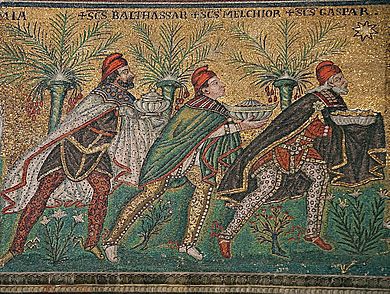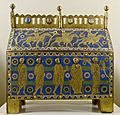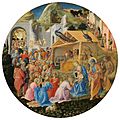Biblical Magi facts for kids

| Major events in Jesus's life in the Gospels |
|---|
|
The biblical Magi ( or singular: magus), also referred to as the (Three) Wise Men or (Three) Kings, also the Three Magi were distinguished foreigners in the Gospel of Matthew and Christian tradition. They are said to have visited Jesus after his birth, bearing gifts of gold, frankincense and myrrh. They are regular figures in traditional accounts of the nativity celebrations of Christmas and are an important part of Christian tradition.
Matthew is the only one of the four canonical gospels to mention the Magi. Matthew reports that they came "from the east" to worship the "king of the Jews". The gospel never mentions the number of Magi. Still, most western Christian denominations have traditionally assumed them to have been three in number, based on the statement that they brought three gifts. In Eastern Christianity, especially the Syriac churches, the Magi often number twelve. Their identification as kings in later Christian writings is probably linked to Isaiah 60:1–6, which refers to "kings [coming] to the brightness of your dawn" bearing "gold and frankincense". Further identification of the magi with kings may be due to Psalm 72:11, "May all kings fall down before him".
Images for kids
-
The three Magi (named Balthazar, Caspar and Melchior), from Herrad of Landsberg's Hortus deliciarum (12th century)
-
James Tissot: The Magi Journeying (c. 1890), Brooklyn Museum, New York City
-
Adorazione dei Magi by Bartolomé Esteban Murillo, c. 1655 (Toledo Museum of Art, Ohio)
-
Adoración de los Reyes Magos by El Greco, 1568 (Museo Soumaya, Mexico City)
-
The Shrine of the Three Kings in Cologne Cathedral, Germany, c. 1200.
-
Journey of the Magi (top) and Adoration of the Magi (side) on a Limoges champlevé chasse, c. 1200 (Musée de Cluny, Paris)
-
Sternsinger in Vienna, Austria
-
Adoration of the Magi, tondo by Fra Angelico and Filippo Lippi, c. 1450 (NGA, Washington)
See also
 In Spanish: Reyes Magos para niños
In Spanish: Reyes Magos para niños













